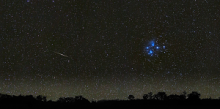Article
A cluster of seven stars located outside of our solar system. Historically, the Pleiades were very important to many world cultures. For people in the Northern Hemisphere, when the Pleiades rise above the eastern horizon, it marks the beginning of spring and the beginning of planting season. For the Ancient Greeks and other mariners of the ancient world, the appearance of the Pleiades in the night sky signified sailing season in the Mediterranean.
The Pleiades are also known as the Hard Flint Boys in some versions of Navajo tradition. According to these versions of Navajo mythology, after the earth was separated from the sky, Black God had a cluster of seven stars, the Hard Flint Boys, on his ankle. Every time Black God stamped his foot, the Flint Boys would jump up to his knee, hip, shoulder and finally his forehead, where eventually they remained. When this happened, it revealed to everybody that Black God was in charge of the sky. In fact, today, we still can see the Flint Boys, namely the Pleiades, high in the sky in autumn and winter.
"Meteor at the Pleiades, November 27, 2011" by Luis Argerich is licensed under CC BY-NC.
Manuscripts
References
Andrews, Munya
2010 The Seven Sisters of the Pleiades: Stories from Around the World. North Melbourne,
Victoria: Spinifex Press.
Encyclopædia Britannica Online
N.d. Pleiades. http://www.britannica.com/EBchecked/topic/464556/Pleiades, accessed
December 08, 2014.

